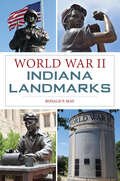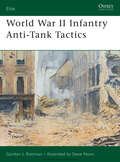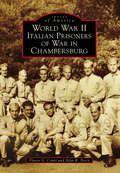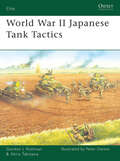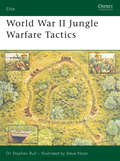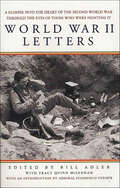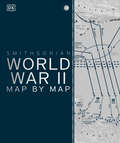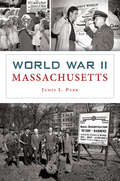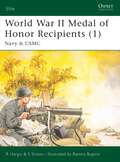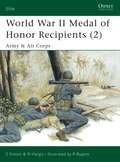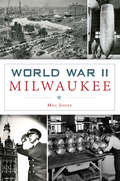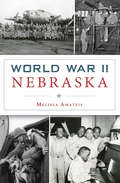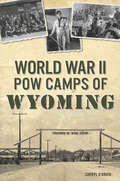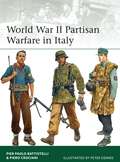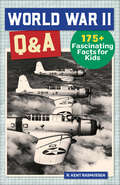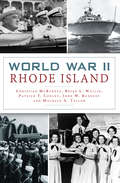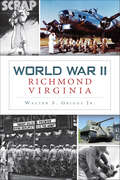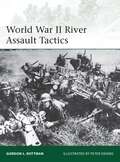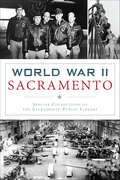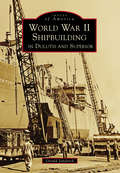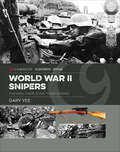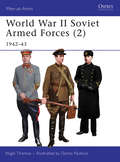- Table View
- List View
World War II Indiana Landmarks (Military)
by Ronald P. MayWorld War II Indiana Landmarks features places throughout the state that played significant roles during World War II. Many of these locations memorialize those who fought as well as those who contributed to the war effort. These places of remembrance include historical sites, monuments, markers, museums, surviving buildings, a surviving Navy ship, a surviving plane, and more. Author Ronald P. May explores the rich historical backgrounds surrounding each location and tells the personal stories of veterans and civilians related to many of these locations.
World War II Infantry Anti-Tank Tactics
by Steve Noon Gordon RottmanThe battlefield interaction between infantry and tanks was central to combat on most fronts in World War II (1939-1945). The first 'Blitzkrieg' campaigns saw the tank achieve a new dominance. New infantry tactics and weapons - some of them desperately dangerous - had to be adopted, while the armies raced to develop more powerful anti-tank guns and new light weapons. By 1945, a new generation of revolutionary shoulder-fired AT weapons was in widespread use. This book explains in detail the shifting patterns of anti-tank combat, illustrated with photographs, diagrams and colour plates showing how weapons were actually employed on the battlefield.
World War II Italian Prisoners of War in Chambersburg (Images of America)
by Alan R. Perry Flavio G. ContiDuring World War II, the US government interned more than 1,200 captured Italian soldiers at the Letterkenny Army Ordnance Depot located near Chambersburg, Pennsylvania. These troops collaborated with the United States in a collective effort to defeat the Axis powers. They formed the 321st Italian Quartermaster Battalion, and their work consisted mainly of stocking and shipping materials�ammunition, military vehicles, weapons, and machinery parts�to the war fronts in the European and Pacific theaters of operation. For entertainment, the soldiers formed an orchestra and band and for sport, several different company soccer teams. As a sign of their faith, they built a chapel and bell tower, which are still used today. Many POWs forged deep friendships with Americans, and after the war, a few married their sweethearts and returned to live in the United States. Today, warm relations still continue between children and grandchildren of the POWs and the wider Chambersburg community.
World War II Japanese Tank Tactics
by Peter Dennis Gordon RottmanOsprey's examination of Japan's tank figting tactics during World War II (1939-1945). In this book expert author and tactician Gordon L Rottman provides the first English-language study of Japanese Army and Navy tank units, their tactics and how they were deployed in action. The Japanese army made extensive use of its tanks in the campaigns in China in the 1930s, and it was in these early successes that the Japanese began to develop their own unique style of tank tactics. As Japanese tanks battled in Singapore, Malaya and Burma this Japanese vision became clearer as light tanks were deployed in the jungles of southeastern Asia, where conventional Western tactics dictated that tanks would be useless.From the steam-rolling success of the Japanese as they invaded Manchuria until the eventual Japanese defeat, the book provides a battle history of the Japanese tank units as they faced a variety of enemies from the Chinese, to the Russians, to the British and the Americans, providing a fascinating insight into the range of tactics that were deployed against these contrasting enemies - from innovative attack procedures to desperate defensive maneuvers even as their tanks were rapidly outclassed in terms of design and armament.From the Trade Paperback edition.
World War II Jungle Warfare Tactics
by Steve Noon Stephen BullOsprey's examination of jungle warfare tactics of World War II (1939-1945).Suffocating heat, tropical rain and hostile jungle terrain were but a few of the treacherous obstacles that confronted the Allies when they fought against the Imperial Japanese Army in the Southeast Asian rainforest.Aided by the knowledge of the terrain, the Japanese were consistently successful in their advances during the winter of 1941-42. However, once the Allies realized that unconventional means and specific jungle skills would be needed in order to survive and win, they developed effective units able to fight the Japanese in this hostile environment.Lessons were learned by the few British soldiers trapped in the central Malaysian jungle by the time of the fall of Singapore and Malaya. In Burma, Orde Wingate led the Chindits, an allied force that trained in jungle discipline, field craft, survival skills, and special tactics such as combat tracking, close-quarter fighting, and small team operations. These men were responsible for pioneering the key jungle warfare tactics that are still practised effectively to this day.Providing an expert analysis of tactical warfare, this book explains the early successes of the Japanese and highlights how the Allies overcame many physical and psychological impairments, to master the art of jungle warfare and finally conquer the strange and claustrophobic jungle environment.
World War II Letters: A Glimpse into the Heart of the Second World War Through the Eyes of Those Who Were Fighting It
by Tracy Quinn McLennanA poignant collection of letters from World War II soldiers, accompanied by photographs.Writers from twenty Allied and Axis countries are gathered in this unique collection of letters from servicemen and -women to their friends, families, and sweethearts. World War II Letters gives an unbiased look into the lives of those who served throughout the world-in Europe, the Pacific, Northern Africa, and Asia-and gives an intimate and honest portrayal of their experiences.Wide ranging in scope, World War II Letters includes writings by officers and infantry, nurses and doctors, pilots, POWs, those injured in action, killed in action, and those reported missing. Introductory biographies and photographs vividly capture the letter writers' lives before, during, and after the war.The writers of the letters in this powerful collection express their own views of "the enemy," give their impressions of countries far away from home, describe battle by land, sea, and air, and recount war's atrocities and its rare humorous moments. Ultimately, World War II Letters provides a revealing and unforgettable journey through the war of the century.
World War II Map by Map (DK History Map by Map)
by DKExplore World War II in unprecedented detail with this compelling geographical guide. If you're interested in finding out more about one of the deadliest wars in history, then this war book is perfect for you. World War II Map by Map is an intricately detailed history book, that will encourage you to get a sense of the magnitude, mobility and speed at which the colossal armies swept through these vast landscapes during a war that claimed millions of lives and spanned through many areas globally. Follow the key developments of World War II in unprecedented visual detail, with more than 100 specially created historical maps covering all major theatres of war. Discover how the conflict raged around the globe on land, air, and sea, while timelines provide an in-depth chronology of events. Beautiful archival photographs, contemporary artefacts, and profiles of famous leaders reveal the full story of the war that shaped the modern world. So what are you waiting for? Journey back in time and uncover: - 9 main contemporary maps, including battle maps from both Allies and Axis countries, explain key events. - Easy-to-read text panels to accompany the maps for a deeper understanding of each topic. - Set out into 5 Chapters with 11 narrative overviews- 30 photo feature spreads exploring topics beyond the War- Produced in association with the Smithsonian Institution. Bursting with striking illustrations and full of fascinating detail, this world war 2 book is the ultimate gift for history students, general readers, and military history enthusiasts. Whether you enjoy watching military documents, or you&’re looking for the perfect gift for the history lover in your life, World War II Map by Map can be enjoyed by adults and children aged 12+ alike. Written by a team of historians headed by Richard Overy as a consultant, this history book for adults examines in detail how the most destructive conflict in history changed the face of our world. At DK, we believe in the power of discovery.So why stop there? The Map by Map series includes other titles such as History of the World Map by Map and Battles Map by Map, each detailing historical events and placing them in the context of geography. DK's luxurious Map by Map books are fantastic history gifts, packed with fascinating facts, high-quality photography, and detailed profiles and descriptions of people and events.
World War II Massachusetts (Military)
by James L. ParrOver 500,000 Massachusetts residents answered the call to military duty in the Second World War, while the rest of the state's citizens fought the war on the home front. Everyone in the family, including pets, found creative and essential ways to contribute. Thousands worked in factories, volunteered for Civil Defense, watched for enemy aircraft, and took part in salvage collections and bond drives, all while dealing with rationing, blackouts, rumors and a host of other wartime inconveniences. And while thousands of service members left to fight overseas, the Bay State also welcomed thousands more to serve on its military bases that were such an important part of our nation's defense. Author James Parr reveals the stories of these brave and dedicated citizens--from the famous to the ordinary--as they faced wartime challenges.
World War II Medal of Honor Recipients
by Ramiro Bujeiro Robert HargisThe Medal of Honor is the highest military award that can be bestowed on personnel in the United States' Armed Forces. This book is the first of two titles looking at the recipients of the Medal of Honor during World War II (1939-1945). It covers Navy and Marine Corps awardees in all theaters of war, from the attack on Pearl Harbor in 1941 to the brutal fighting on Iwo Jima in 1945. Among the inspiring stories told are those of Signalman 1st Class Douglas Munro, the only Coast Guardsman to ever receive the Medal of Honor, and Commander Antrim, who faced almost certain death to save fellow prisoners in a Japanese prisoner of war camp.
World War II Medal of Honor Recipients
by Ramiro Bujeiro Starr SintonThe Medal of Honor is the highest award for valor in action against an enemy force that can be awarded to personnel in the United States' Armed Forces. From the early fighting in the Philippines through the D-Day landings in Northwest Europe to the final assaults in the Pacific, this book looks at the brave US soldiers and airmen who were awarded the Medal of Honor for their actions in the face of danger. It tells the exciting combat stories of such famous figures as the film star Audie Murphy, one of the most decorated US soldier of World War II (1939-1945), alongside less well-known awardees.
World War II Memoirs: The European Theater (LOA #385)
by Charles B. Macdonald Mary Lee Settle J. Glenn Gray Elmer BendinerOn the 80th anniversary of the war's end, 5 classic memoirs capture firsthand the shock, terror, and courage of the American fight against the Axis powers in Europe"The emotional environment of warfare has always been compelling," writes J. Glenn Gray in his incomparable World War II memoir and mediation, The Warriors. "Reflection and calm reasoning are alien to it." The struggle to make sense of the experience of war, to find some meaning in the savagry and senseless destruction, animates the five brilliant and unforgettable memoirs gathered here. Company Commander (1947), by Charles B. MacDonald, describes with startling immediacy and candor the &“cold, dirty, rough, frightened, miserable&” life of the infantryman and company commander from the aftermath of D-Day in September 1944 through the war's terrifying final days.The Warriors (1959), by J. Glenn Gray, a counterintelligence officer who served in Italy, France, and Germany and a scholar with a PhD. in philosophy, is a sensitive and revelatory meditation on the nature of war and its effects on both soldiers and civilians, interspliced with his letters, journals, and wartime memories. All the Brave Promises (1966) is novelist Mary Lee Settle&’s memoir of her year as an airfield radio operator in the Royal Air Force. Settle brilliantly evokes both the working-class culture of the Women&’s Auxiliary Air Force&’s &“other ranks&” and the petty and demeaning regimentation inherent in military life.The Fall of Fortresses (1980), by former B-17 navigator Elmer Bendiner, vividly recalls the fear and excitement he experienced flying bomber missions deep into Germany in 1943 without fighter escort.The Buffalo Saga (2009) is James Harden Daugherty&’s heartfelt account of his frontline service as a Black soldier in the 92nd Infantry Division, as he fights the Germans, endures the harsh Italian winter, and confronts the racism of his own army.This deluxe Library of America volume includes full-color endpaper maps of the European Theater, an eight-page photo insert, an introduction by West Point professor Elizabeth D. Samet, and detailed notes.
World War II Milwaukee (Military)
by Meg JonesLong before Japanese bombs rained down on Pearl Harbor, Milwaukee was the "Machine Shop to the World." Thanks to the city's large industrial base, factories quickly retooled and mobilized for wartime production. Harley-Davidson produced thousands of military motorbikes, and Falk Corporation churned out gears that turned the propellers on hundreds of ships. Locals sacrificed their lives for the cause--Mayor Carl Zeidler went missing at sea, USS Arizona captain Franklin Van Valkenburgh refused to leave the bridge of his burning battleship and Mildred Harnack joined the Nazi resistance movement and was executed on direct orders from Hitler. Embedded with German and American troops, Milwaukee journalists H.V. Kaltenborn, Louis Lochner and Dickey Chapelle sent dispatches from the front lines. Through past interviews and archival materials, author Meg Jones reveals these and other patriotic stories.
World War II Nebraska: A History Of World War Ii Prisoners In The Heartland (Military)
by Melissa AmateisThe fight against the Axis required sacrifice and dedication, and Nebraskans proudly answered the call. Three ordnance plants and two naval munitions depots brought employment and economic opportunities but also housing shortages and racial disturbances. The U.S. Army Air Corps established eleven air bases here, leading to community engagement through USOs and war bond drives. In central Nebraska, the North Platte Canteen welcomed thousands of service members en route to war on troop trains. Henry Doorly's successful scrap campaign became a model for a nationwide operation. Local farmers fed the nation, K-9 war dogs trained at Fort Robinson and native sons Ben Kuroki and Andrew Higgins affected the war in very different ways. Through detailed archival research, author Melissa Amateis tells the remarkable story of the Cornhusker State's homefront.
World War II POW Camps in Ohio (Military)
by Dr James KeurenDuring World War II, more than six thousand prisoners of war resided at Camp Perry near Port Clinton and its branch camps at Columbus, Rossford, Cambridge, Celina, Bowling Green, Defiance, Marion, Parma and Wilmington. From the start, the camps were a study in contradictions. The Italian prisoners who arrived first charmed locals with their affable, easygoing natures, while their German successors often put on a serious, intractable front. Some local residents fondly recall working alongside the prisoners and reuniting with them later in life. Others held the prisoners in disdain, feeling that they were coddled while natives struggled with day-to-day needs. Drawing on first-person accounts from soldiers, former POWs and residents, as well as archival research, Dr. Jim Van Keuren delves into the neglected history of Ohio's POW camps.
World War II POW Camps of Wyoming (Military)
by Cheryl O'BrienA detailed history of where German & Italian prisoners of war stayed in Wyoming during WWII, featuring archival photographs. Wyoming&’s nineteen prisoner of war camps held several thousand incarcerated Italian and German prisoners during World War II. Historical records, photographs and personal stories shared by camp residents reveal details about this little-known part of the state&’s history. Local agricultural and timber industries utilized POW labor, while positive relationships developed between the camp's civilian area residents and prisoners. Author Cheryl O&’Brien recounts the experiences of the prisoners and the intriguing story of how US military personnel, prisoners and residents—despite their differences—collaborated to cope with the challenges of life in a POW camp.
World War II Partisan Warfare in Italy
by Pier BattistelliWhen Italy surrendered in 1943, it sparked a diverse resistance movement of anti-German, anti-fascist partisans who rose up against German occupation. This book explores the tactics, organizational structure and equipment of the brave Italian resistance fighters, who knew exactly what was at stake when operating against their German occupiers. Beginning with low-level sabotage and assassinations, the groups grew until spring 1944 when they numbered around 100,000, and as the Allies advanced to the Gothic line, a remarkable, unified partisan command structure was created. The partisans began to work in close co-ordination with the Allies, receiving British SOE and American OSS liaison teams as well as supplies of weapons. The German response was eye-watering in its ferocity and brutality, as the SS and Italian RSI looked to eradicate the partisans once and for all when the Allied advance stalled in Autumn 1944. But when the Allies made their final breakthrough in the last weeks of the war the partisans rose in force to pile the pressure on the retreating Wehrmacht. From an expert on Italian military history in World War II, this work provides an exhaustively researched, sumptuously illustrated guide to the men and women who fought a desperate struggle against occupation, as well as the German and Italian fascist security forces unleashed against them.
World War II Q&A: 175+ Fascinating Facts for Kids (History Q&A)
by R. Kent RasmussenInteresting facts that teach kids ages 8 to 12 all about World War IIWas the Second World War a continuation of the First World War? How did children in the United States contribute to the war effort? Help young learners find the answers to these questions and more in this close-up look at the largest conflict the world has ever known. They'll learn how it began, who fought in it, and the ways it affected lives all around the globe—one unbelievable fact at a time.Go beyond other World War 2 books with:175+ amazing things to know—Kids will step back in time and explore the history of World War II with Q&As, true or false questions, and more.Easy-to-share facts—Provide kids with bite-sized facts that are simple to remember and exciting to tell their friends and family.A complete overview—Young learners will examine how the war started, the new ways it was fought, the effects it had on the lives of ordinary people, and more.Make learning about history easy with this top choice in books about World War 2.
World War II RAF Airfields in Norfolk: Lincolnshire, Norfolk, Yorkshire, Northamptonshire
by Martin W. BowmanAs part of the Aviation Heritage Trail series, this book covers airfields in Lincolnshire, Norfolk, Yorkshire and Northamptonshire. 12 Group was formed in 1937 within Fighter Command to become responsible for aerial defense of the industrial Midlands. During World War Two this group was the second most important fighter group and as such, it received it's fair share of attacks from the German Luftwaffe throughout the war. As well as regional defense, 12 Group were also supposed to fly cover for 11 Group airfields during the Battle of Britain. The airfields and other places of interest include Digby, Hibaldstow, Kirton on Lindsey, Coltishall, Matlask, Swanton Morley, Catterick, Church Fenton, Clifton, Hutton Cranswick and WitteringThis book looks at the history and personalities associated with each base, what remains today and explores the favorite local wartime haunts. Museums and places that are relevant will also be described and general directions on how to get them included.
World War II Rhode Island (Military)
by Maureen A. Taylor Patrick T. Conley Brian L. Wallin Christian Mcburney John W. KennedyRhode Island’s contribution to World War II vastly exceeded its small size. Narragansett Bay was an armed camp dotted by army forts and navy facilities. They included the country’s most important torpedo production and testing facilities at Newport and the Northeast’s largest naval air station at Quonset Point. Three special, top-secret German POW camps were based in Narragansett and Jamestown. Meanwhile, Rhode Island workers from all over the state—including, for the first time, many women—manufactured military equipment and built warships, most notably the Liberty ships at Providence Shipyard. Authors from the Rhode Island history blog smallstatebighistory.com trace Rhode Island’s outsized wartime role, from the scare of an enemy air raid after Pearl Harbor to the war’s final German U-boat sunk off Point Judith.
World War II Richmond, Virginia (Military)
by Walter S. Griggs Jr.The effects of the war raging across Europe were visible in Richmond as early as 1939, and Richmonders are always ready to fight for their cause. In that year, the city saw its first parking meters on the streets and began to collect aluminum scrap for use in war industries. In 1940, pursuant to the new draft law, Richmond's sons between the ages of twenty-one and thirty-five registered for the draft. While bomb shelters were put up all over the town, dances were held to maintain local morale. Even as local German families faced discrimination, Richmonders strived for a sense of unity and solidarity. Author and historian Walter Griggs Jr. revives this conflicted spirit, memorializing the sorrow and celebrating the triumphs of a resilient southern city through world war.
World War II River Assault Tactics
by Peter Dennis Gordon RottmanOn the major European and Russian fronts throughout World War II, the challenge of crossing rivers and other water obstacles under fire was absolutely central to any advance. The Panzers that crossed the Meuse at Sedan in May 1940 cut the French Army in two; the Wehrmacht's ability to cross the great rivers of the western USSR was vital to the lightning advances of Operation Barbarossa in 1941, and in 1943-45 the Red Army had to drive the Germans back from a succession of river lines during their advance to the Reich, culminating in the Vistula and Oder lines; in Italy the Rapido formed a bloody moat for the Cassino defences; and after D-Day the milestones on the Western Allies' advances were the Seine, the Somme, the Moselle, and finally the Rhine. The initial (hopefully surprise) assault could be made by infantry in light assault boats, and over rudimentary improvised bridges. But World War II armies depended on heavy mechanized equipment, and even if a bridgehead was seized, it then had to be held for long enough for engineers to bring up and erect prefabricated bridges strong enough to carry the tanks and artillery without which the bridgehead was doomed. Some of the most savage fighting of the war took place around bridgeheads, and the Allies invested considerable resources in the development of equipment and tactics for contested river crossings.This book explains the methods and the means, and analyzes specific successes and failures. It features a wealth of wartime photos, particularly from German sources, and full-color plates illustrate tactical scenarios that bring the subject alive.
World War II Sacramento (Military)
by Special Collections of the Sacramento Public LibrarySpurred into action by the attack on Pearl Harbor, Sacramento dragged itself out of the morass of the Great Depression and joined the war effort. Local citizens trained for Japanese attacks through Civilian Defense, cultivated thousands of acres of victory gardens and harnessed the agricultural riches of the region. Tens of thousands engaged in war work at local bases like the new McClellan Field, while Sacramento's diverse servicemen distinguished themselves in combat overseas. They would later return and transform the city into the modern Sacramento of today. Exclusive images and stories from the Special Collections of the Sacramento Public Library bring this story to life.
World War II Shipbuilding in Duluth and Superior (Images of America)
by Gerald SandvickWorld War II hinged on the Allies having enough ships to both fight the enemy and to carry millions of tons of war goods across the world’s oceans. Shipyards on the Atlantic, Gulf, and Pacific Coasts built thousands of vessels, but America’s sometimes forgotten Fourth Coast, the Great Lakes, built hundreds of ships as well. From 1940 to 1945, warships, cargo haulers, Coast Guard tenders, and fleet service auxiliaries of many types were launched from the two cities of Duluth, Minnesota, and Superior, Wisconsin, which lie at the far western end of Lake Superior. During the war, half a dozen shipyards in Duluth-Superior produced more than 200 vessels of 10 main types, up to 338 feet long and 5,000 tons, all having to make close to a 2,400-mile journey to the ocean. The shipyards grew from nearly nothing in 1939 to become industries employing thousands of men and women by 1945 and making a major contribution to the story of America in World War II.
World War II Snipers: The Men, Their Guns, Their Stories (Casemate Illustrated Special)
by Gary YeeThis illustrated military history reveals the untold story of WWII snipers, from training and firearms to combat and field operations.Though snipers played a significant role in the battlefields of World War II, they are often overlooked by historians. In this volume, military historian and firearms expert Gary Yee offers a comprehensive and fully illustrated narrative of snipers across the major theaters of conflict: Europe, the Eastern Front, and the Pacific. Drawing on memoirs, archives, wartime photographs, and eyewitness accounts, World War II Snipers presents a compelling and authoritative study.Each of the warring countries had its own unique methodology for selecting and training snipers. They recruited hunters, outdoorsmen, competitive shooters, and military veterans to take on this highly skilled role. They were deployed to ensure battlefield dominance and instill a paralyzing fear among the enemy. Yee tells the stories of these soldiers who were both admired and at times reviled by their own comrades. He also includes a lengthy chapter on the sniper rifles and other equipment issued to snipers.
World War II Soviet Armed Forces
by Nigel Thomas Darko PavlovicThis title presents a detailed analysis of the Soviet Army at the outbreak of World War II (1939-1945), including the Red Army's campaigns against Japan on the Manchurian plains as well as in Finland. It also covers the Red Army's first operations during Operation Barbarossa when the Red Army was forced to defend Mother Russia against the German onslaught. With a breakdown of all the armed forces including the army, air force, paratroopers, navy and NKVD troops, author Nigel Thomas gives special attention to the evolution of uniforms, equipment and insignia with the introduction of new regulations in 1935 and 1940.
